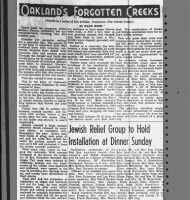Oakland's Forgotten Creeks
By Dave Hope
(Fourth in a series of five articles. Tomorrow - The Creeks Today.)
There must be moments when Mother Nature, reviewing her accomplishments, wonders why she created man.
Consider her gorgeous setting for a gem-like Bay. She placed it at the base of ascendant hills. She crowned them with towering redwoods, carpeted their slopes with luxuriate oaks and verdant grass. Through the forests and fields she traced paths for 21 creeks, fed them from thousands of bubbling springs, used them to transport life-producing water. She populated the land with birds and animals, stocked the streams with fish. She created a pristine paradise of life and beauty.
Then she turned it over to man.
This is the story of Oakland's forgotten creeks, forgotten by man, because of man.
When nature completed her centuries of work, her creeks ran merrily from the San Antonio redwoods to the bay. The muddied torrents of winter storms cleared to sparkling streams that flowed the year around.
Today they rise in sudden turbulence, subside quickly, and become arid ravines within a few weeks after the rain ceases. That, in not quite one century, is man's handiwork.
Nature created a huge natural reservoir, which released its moisture slowly, at consistent rate, throughout the year. Every leaf, each blade of grass, each grain of soil and the roots that spread beneath the surface, soaked up the rain as it fell and protected it from. the thirsty summer sunbeams.
Then came man, intent on logging the redwoods. With careless disregard of the future, the builders of San Francisco denuded the ridges. Tall trees were reduced to withering stumps and the headwaters of the creeks, once sheltered and protected, were opened to the rays of parching sun. Springs dried up, and creeks were diminished at their source.
They still had the protection of vegetation on slopes and lowlands, but not for long. As men sought homesites, the oaks were felled. Brush and native perennials were replaced by annually harvested hay and grain, cattle fed off the grass, and farmers tilled the soil, extracting moisture in their crops. Homes were built, at first a few, then in ever growing clusters that merged into each other to form a city. Streets were cleared, graveled, and later paved.
Instead of a reservoir, the area became a huge watershed of roofs and streets and sidewalks. Rain that once would have been absorbed ran quickly, off impenetrable surface into the nearest creek bed.
Nature must have mourned the wreckage of her handiwork, but man saw the creeks only as barriers to his progress. The bustling industrial and shipping center along the Estuary, the farms and orchards in the north, both were often inaccessible from the new city of Oakland. In winter creeks ran high with raging flood waters. In summer their sharply eroded banks made traverse precarious.
Man built streets, the earliest following creek banks from the Estuary to the hills. Their tortuous trails remain to confuse Oakland's traffic today. Park Boulevard, 14th Avenue, 23rd Avenue, among others, twist and turn, chopping off dead-end laterals.
Man built bridges - 32 of them in one section alone, now East Oakland. The combination of streets and bridges established lines for today's traffic arteries.
Few who guide their autos over winding routes realize they are tracing the paths of forgotten creeks. None who drive the comparatively straight thoroughfares that run from north to south are aware their gentle grades are superimposed on once rugged terrain.
As property values increased, man encroached closer upon the creeks, finally bridged them over and built homes and business buildings and factories above them.
Codornices has almost entirely disappeared. No visible trace remains of Glen Echo, Broadway, Courtland, Pleasant Valley, Park Boulevard, 14th, 23rd, or 54th Avenues, hardly a bit of Elmhurst. Others emerge from culverts for brief passages, then dive out of sight again beneath the surface.
[See
Creek & Watershed Map of Oakland & Berkeley
- MF]
They're gone, or nearly gone. They're forgotten, or almost so. But they still exist, still perform utilitarian service.
The gurgling, sparkling creeks that nature established to nourish her plant and animal life have become the storm sewers of a great city.
 Oakland's Forgotten Creeks #4 31 Jan 1947, Fri
Oakland Tribune (Oakland, California) Newspapers.com
Oakland's Forgotten Creeks #4 31 Jan 1947, Fri
Oakland Tribune (Oakland, California) Newspapers.com
Comments
Post a Comment